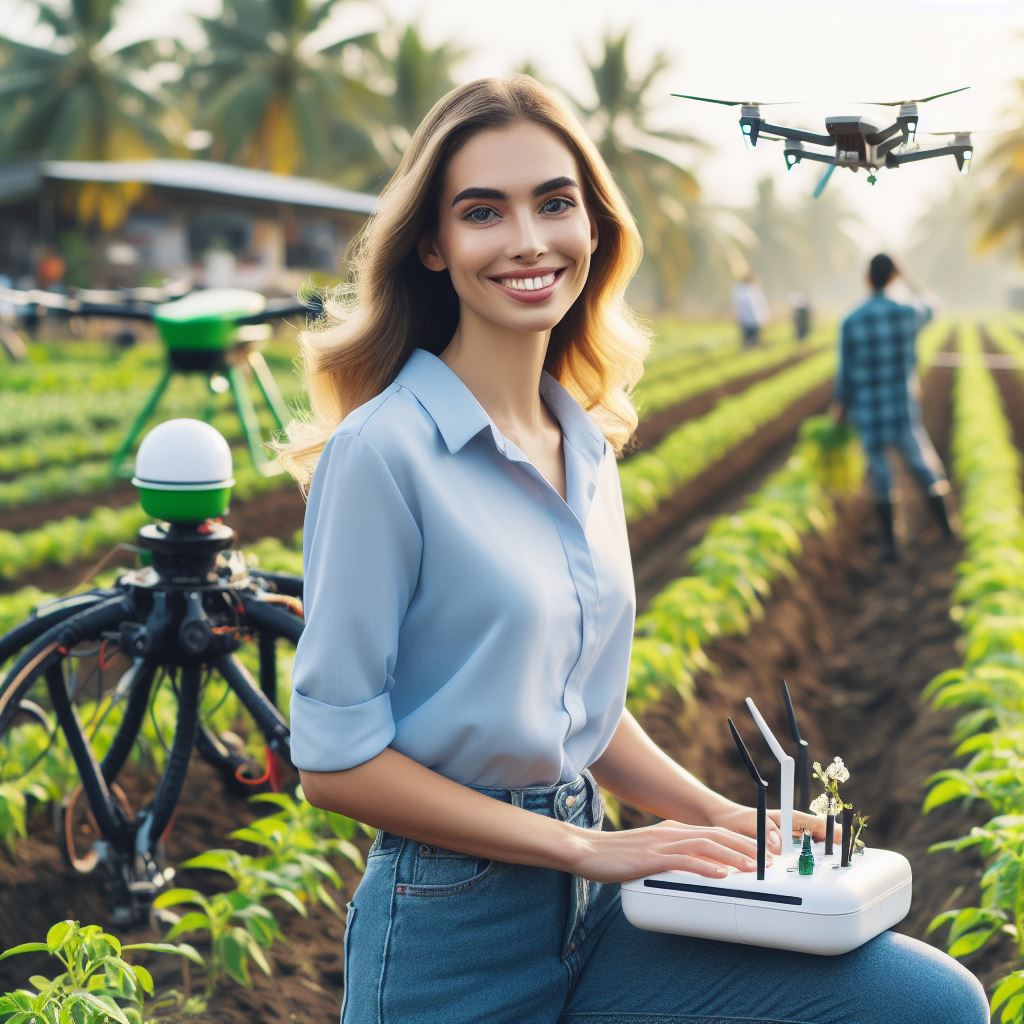Introduction
In recent years, AI has emerged as a transformative force in agriculture, revolutionizing traditional farming practices.
By harnessing the power of advanced technologies, such as machine learning and computer vision, AI has the potential to address the challenges posed by climate change.
The importance of addressing climate change in agriculture cannot be understated.
Agriculture is profoundly impacted by climate variability, including extreme weather events, changing rainfall patterns, and rising temperatures.
These environmental shifts pose significant threats to crop yields, livestock health, and overall food security.
AI can play a pivotal role in mitigating these challenges.
By analyzing vast amounts of data, AI can predict and manage climate-related risks more effectively.
Farmers can use AI-powered systems to optimize irrigation schedules, monitor crop health, and make informed decisions about pest control.
Additionally, AI can assist in breeding resilient crop varieties that withstand changing climatic conditions.
Furthermore, AI’s ability to generate accurate weather forecasts can help farmers plan their operations accordingly.
By utilizing real-time data, AI systems can provide localized weather predictions, enabling farmers to take preventive measures and minimize potential losses.
This proactive approach can contribute to the overall resilience of the agricultural sector.
In short, as climate change continues to impact agricultural systems, harnessing the potential of AI is vital.
Through its data-driven analytics and predictive capabilities, AI can provide farmers with the tools to overcome the challenges posed by climate change.
By embracing AI in agriculture, we can foster a sustainable and resilient food production system for a changing world.
The role of AI in climate change mitigation
AI plays a crucial role in addressing the challenges posed by climate change in agriculture.
By harnessing the power of artificial intelligence, farmers can mitigate the impact of climate change and ensure sustainable food production.
Increasing crop yields
- Precision farming revolutionizes traditional agricultural practices by using AI to optimize inputs such as fertilizers, pesticides, and water. Through the integration of sensor technologies and real-time data analysis, farmers can identify localized variations in soil and crop conditions. This enables them to make informed decisions and apply the right amount of inputs to achieve maximum crop productivity while minimizing wastage.
- Machine learning algorithms are employed to predict crop yields based on historical data, weather patterns, and other factors. By analyzing extensive datasets, AI models provide accurate yield estimates, facilitating better resource allocation and planning. This information helps farmers optimize production, reduce losses, and ensure maximum yields, even under changing climate conditions.
Monitoring and managing water usage
- Sensor technology plays a crucial role in monitoring soil moisture levels, precipitation, and water consumption. The sensors collect real-time data and transmit it to AI systems. This data enables farmers to make informed decisions about irrigation, ensuring optimal plant health and conservation of water resources.
- Data analysis is vital in water management. AI algorithms process and analyze large volumes of data to create models that predict water requirements for different crops and growth stages. By optimizing irrigation schedules and reducing water wastage, AI helps conserve water in agriculture, a sector that accounts for a significant amount of global freshwater consumption.
Improving pest and disease control
- Early detection and prediction of pest infestations are critical for effective pest control. AI-powered systems analyze various data sources, including satellite imagery, weather patterns, and historical pest data, to identify the early signs of pest outbreaks. This enables farmers to take preventative measures, such as targeted spraying or biological control, reducing the need for excessive pesticide use.
- Autonomous pest management systems leverage AI and robotics to monitor crop health, detect pests, and apply targeted treatments. These systems use image recognition and machine learning to identify pests and diseases accurately. By automating the process, farmers can reduce the reliance on chemical pesticides, protect beneficial insects, and minimize the environmental impact.
In fact, AI offers immense potential to mitigate the challenges of climate change in agriculture.
By increasing crop yields through precision farming and machine learning algorithms, monitoring and managing water usage efficiently, and improving pest and disease control through early detection and autonomous systems, AI enables farmers to adapt to changing climate conditions and ensure sustainable food production.
The integration of AI in agriculture is crucial for a resilient and climate-smart farming future.
Read: Next-Gen Farms: AI in Water Management
AI in climate change adaptation
AI in agriculture plays a vital role in mitigating climate change impacts and ensuring sustainable food production.
By leveraging AI technologies, farmers can analyze climate patterns accurately, improve irrigation efficiency, and enhance plant breeding techniques.
Analyzing climate patterns
Climate change poses significant challenges for agriculture, making it crucial to analyze climate patterns accurately.
AI tools, such as climate models, enable farmers to assess and understand complex climate systems.
These models incorporate various inputs, including historical climate data, greenhouse gas emissions, and agricultural practices.
By analyzing these patterns, farmers can anticipate future climate trends and adjust their agricultural practices accordingly.
Additionally, predictive analytics plays a crucial role in climate change adaptation.
AI algorithms can process vast amounts of climate data and forecast weather patterns accurately.
By leveraging predictive analytics, farmers can make informed decisions regarding crop selection, planting schedules, and pest control.
This helps optimize crop yields and minimize the risks associated with climate variability.
Improving irrigation efficiency
Irrigation plays a critical role in agriculture, especially in water-scarce regions.
AI technologies offer innovative solutions to enhance irrigation efficiency and conserve water resources.
Smart irrigation systems leverage AI algorithms to automate irrigation processes.
These systems integrate real-time data from weather forecasts, soil moisture sensors, and crop water requirements.
By analyzing this data, AI algorithms determine the precise amount of water needed for irrigation, ensuring optimal soil moisture levels and minimizing water wastage.
This not only improves crop productivity but also conserves water resources.
Furthermore, AI facilitates optimal resource allocation in irrigation.
By considering various factors such as soil type, crop type, and weather conditions, AI algorithms optimize water usage.
This data-driven approach ensures efficient irrigation practices and reduces water stress on plants.
Enhancing plant breeding techniques
Plant breeding is essential for developing crop varieties that are resilient to climate change impacts.
AI empowers farmers and scientists to enhance plant breeding techniques and accelerate the development of climate-resilient crops.
Transform Your Agribusiness
Unlock your farm's potential with expert advice tailored to your needs. Get actionable steps that drive real results.
Get StartedGenetic algorithms, a subset of AI, simulate natural selection to identify desirable traits in plants.
By analyzing genetic data, AI algorithms assist in the selection and breeding of plants with traits such as drought tolerance, disease resistance, and high yield potential.
This enables the development of crop varieties that can withstand changing climatic conditions.
Accelerated breeding programs leverage AI technologies to expedite the breeding process.
By analyzing vast amounts of genetic data, AI algorithms identify superior plant varieties for cross-breeding.
This reduces the time required to develop new crop varieties, enabling farmers to adapt to changing climate conditions quickly.
In general, AI in agriculture plays a crucial role in facing the challenges of climate change.
By analyzing climate patterns, improving irrigation efficiency, and enhancing plant breeding techniques, AI empowers farmers to adapt to climate change and ensure sustainable food production.
With continued advancements in AI technology, the agricultural sector can mitigate the adverse effects of climate change and achieve long-term resilience.
Read: Diverse Crops: A Shield Against Climate Shifts

Delve into the Subject: Farming Strategies for Dry Climates
Challenges and Limitations of AI in Agriculture
Data Quality and Accessibility
- Limited availability of high-quality data poses a significant challenge for the implementation of AI in agriculture.
- Inaccurate or incomplete data can lead to faulty predictions and inefficient decision-making processes.
- Farmers may face difficulties in accessing relevant agricultural data due to technological barriers or lack of resources.
- Ensuring data privacy and security is crucial, considering the sensitive nature of agricultural data.
- Developing standardized data formats and establishing data-sharing protocols can enhance data accessibility and quality.
Implementation and Adoption Hurdles
- Integrating AI technologies into existing agricultural practices may require significant investments in infrastructure and training.
- Farmers who lack technical expertise or access to necessary resources may struggle to adopt AI-based solutions.
- Resistance to change among traditional farming communities can pose a considerable hindrance to the implementation of AI.
- Collaborative efforts between government, agriculture organizations, and technology providers are essential to overcome implementation barriers.
- Promoting awareness and demonstrating the potential benefits of AI in agriculture can facilitate its wider adoption.
Ethical Implications of AI Usage
- The use of AI in agriculture raises concerns regarding data ownership, privacy, and potential biases in decision-making algorithms.
- Farmers must have control over their data and be adequately informed about how it is being used.
- Transparency in AI algorithms and decision-making processes is necessary to build trust among farmers and stakeholders.
- The potential for job displacement due to the automation of certain agricultural tasks requires careful consideration.
- Ensuring equitable access to AI technologies and preventing the digital divide in farming communities is crucial.
In review, the integration of AI in agriculture offers immense potential for tackling the challenges posed by climate change.
However, it is essential to address the challenges and limitations surrounding data quality and accessibility, implementation and adoption hurdles, and ethical implications.
By overcoming these obstacles, we can harness the full power of AI to revolutionize agricultural practices and achieve sustainable food production in the face of a changing climate.
Read: Floods & Droughts: Navigating Agri Water Use
Success stories and future prospects
Case studies of successful AI implementation
- AI-powered drones: Drones equipped with AI technology can monitor crop health and detect diseases at an early stage.
- Precision farming: AI algorithms analyze data from sensors to optimize irrigation, fertilization, and pesticide use, increasing crop yields.
- Robotic harvesting: AI-powered robots can accurately and efficiently harvest crops, reducing labor costs and improving efficiency.
- Automated weed control: AI systems can distinguish between crops and weeds, enabling targeted herbicide application and reducing chemical usage.
- Forecasting market demand: AI algorithms can analyze historical data to predict consumer demand and optimize production accordingly.
Potential benefits of AI in the future
- Climate-resilient crops: AI can contribute to developing crops that are more resilient to climate change, ensuring food security.
- Optimized resource management: AI algorithms can help optimize the use of resources like water and fertilizers, minimizing waste.
- Early pest and disease detection: AI-based systems can identify pests and diseases in crops at an early stage, enabling timely interventions.
- Enhanced decision-making: AI can provide farmers with real-time data and insights for better decision-making, leading to increased productivity.
- Improved supply chain management: AI can help streamline the supply chain process, reducing post-harvest losses and ensuring efficient distribution.
Collaborative efforts in AI and agriculture
- Public-private partnerships: Governments, tech companies, and agricultural organizations are collaborating to develop AI solutions for agriculture.
- Research and development: Universities and research institutions are conducting studies to explore the potential of AI in addressing agricultural challenges.
- Data sharing: Collaboration between farmers, researchers, and AI experts allows for the collection and sharing of valuable agricultural data.
- Open-source platforms: Initiatives like OpenAI and TensorFlow provide accessible AI tools and frameworks for agricultural applications.
- Knowledge sharing: Conferences, workshops, and online platforms facilitate the exchange of AI knowledge and best practices in agriculture.
These success stories and collaborative efforts paint a promising future for AI in agriculture.
Harnessing the power of AI can revolutionize farming practices, making them more sustainable, efficient, and resilient to climate change.
As more case studies emerge and technological advancements continue, the potential benefits of AI in agriculture are vast.
It has the ability to tackle the pressing challenges faced by farmers worldwide and ensure food security for a growing population.
By embracing AI in agriculture, we can work towards a greener, more productive, and climate-resilient future.
Read: Reducing Water Footprint in Agri Practices
Conclusion
Recap of AI’s potential in addressing climate change
Throughout this blog, we have discussed the significant role that Artificial Intelligence (AI) can play in agriculture to combat climate change.
AI can assist in various agricultural processes, including crop monitoring, yield prediction, and disease detection.
By leveraging AI technologies, farmers can optimize their resources and make informed decisions, leading to increased sustainability and reduced environmental impact.
Call to action for further research and investment in AI in agriculture
Despite the promising possibilities, there is still much room for improvement and exploration in the field of AI in agriculture.
It is crucial that governments, organizations, and researchers invest more resources in advancing AI technologies specifically tailored for agricultural applications.
This will facilitate the development of innovative tools and systems that can help farmers adapt to the changing climate and ensure food security for future generations.
All in all, AI has emerged as a powerful tool in addressing climate change within the agricultural sector.
It offers immense potential to mitigate the negative environmental impacts of farming practices and enable sustainable agriculture.
However, to fully harness the benefits of AI in agriculture, continued research and investment are essential.




